Key takeaways:
- Sponsorships significantly enhance artist visibility and create memorable experiences for fans when aligned with the artists’ values.
- Key metrics to measure the impact of sponsorships include audience engagement, sales growth, and brand sentiment, which can lead to increased fan loyalty and community building.
- Effective sponsorships reflect shared values and promote positive impacts, emphasizing the importance of genuine connections between brands and artists.
- Personal experiences highlight the potential of sponsorships to drive creativity and amplify diverse voices in the music industry.

Understanding sponsorships in music
Sponsorships in music have evolved into a vital revenue stream, enabling artists and labels to explore new creative avenues. I remember my first partnership with a local beverage company; it felt like a small victory that not only brought in funds but also elevated our brand’s visibility. How often do we overlook the potential impact a well-placed brand can have on an artist’s journey?
At events, I’ve seen firsthand how sponsors can transform the experience for both artists and fans alike. Take, for instance, a sponsored festival stage—suddenly, you have immersive experiences and high-quality production that truly enhance performances. It’s more than just logos on flyers; it’s about creating memorable moments that resonate long after the music fades.
When assessing the value of sponsorships, it’s crucial to consider the alignment between the brand and the music. A beverage that supports an underground electronic act might resonate better than a lavish luxury brand. Have you ever felt a genuine connection with a brand just because it aligns with the music you love? That’s the magic of the right sponsorship!
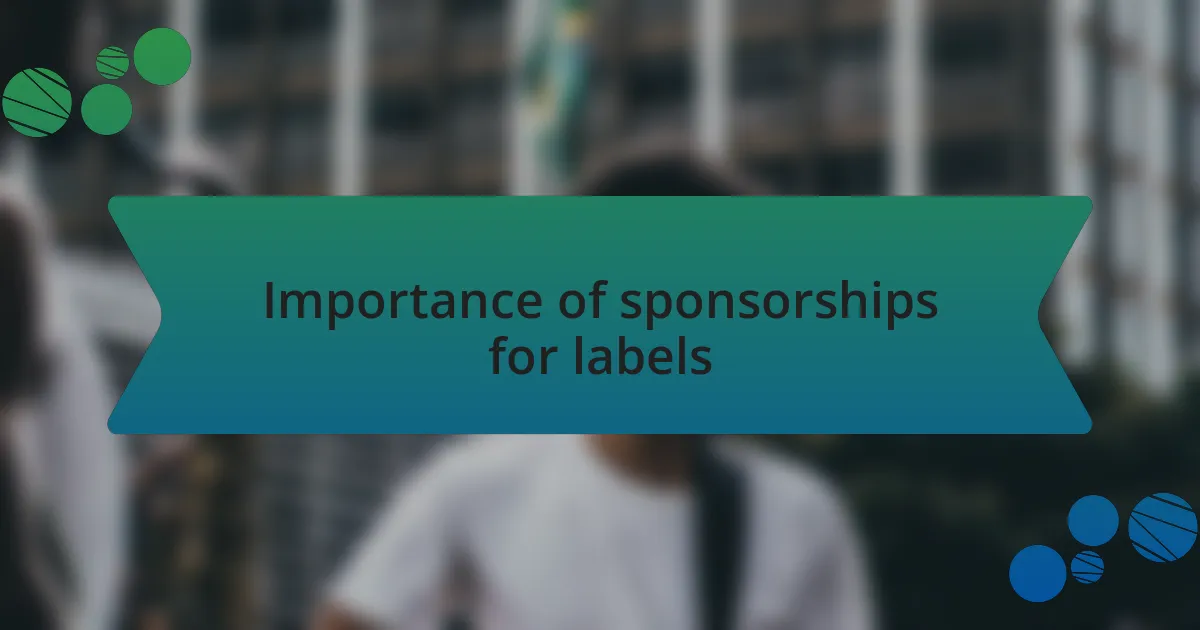
Importance of sponsorships for labels
Sponsorships are essential for labels, as they provide the financial backing necessary to promote artists effectively. I recall a time when our label partnered with a tech company for a music production contest. The funds allowed us not only to support emerging talent but also to invest in marketing—an opportunity we wouldn’t have had otherwise. It’s fascinating to think about how a single sponsorship can help elevate an artist’s profile in a competitive industry.
Moreover, sponsorships foster collaboration and innovation, which are vital in the ever-evolving music landscape. I often think about a high-profile festival we collaborated on, where brand involvement enabled new elements like interactive installations and live-streaming options. These enhancements created a unique environment for fans and left them wanting more. Have you ever attended an event where the sponsor’s involvement genuinely changed your experience?
The right sponsorships can also enhance an artist’s authenticity in the eyes of their audience. I’ve seen this firsthand with a label that aligned with a sustainable fashion brand, reflecting the artist’s values and music style seamlessly. It’s remarkable how this connection can deepen fan loyalty and create a community around shared beliefs. Isn’t it inspiring to witness when brands and artists come together for a common cause?
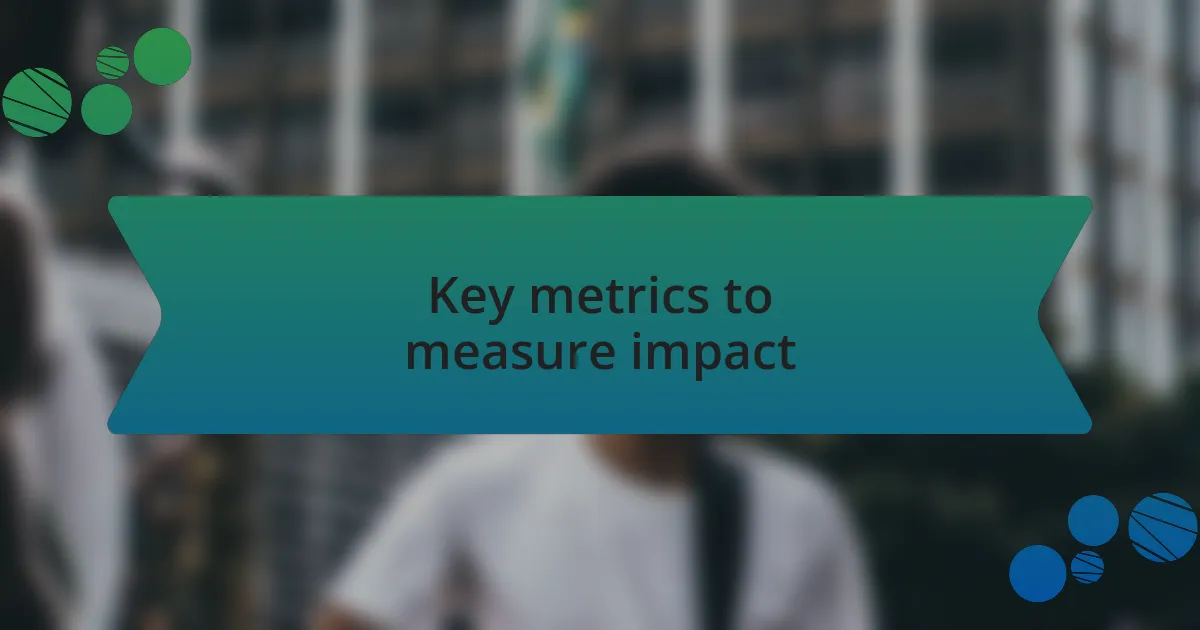
Key metrics to measure impact
One of the primary metrics I focus on when evaluating the impact of sponsorships is audience engagement. I recall analyzing data from a sponsored event where social media interactions skyrocketed—likes, shares, and comments on posts featuring our artists grew exponentially. It got me thinking: how much more connected can artists become with their fans when a brand supports their vision?
Another important metric is sales growth, particularly in relation to merchandise and streaming. I once observed a notable increase in merchandise sales after a sponsorship with a popular lifestyle brand promoted a limited-edition product line. It was eye-opening to see how a strategic partnership could boost not just visibility but also actual revenue. I often wonder how many artists miss out on such opportunities simply due to a lack of understanding of what metrics to track.
Lastly, brand sentiment is crucial for gauging the effectiveness of a sponsorship. I remember a particular campaign where we noticed a shift in audience perception following a collaboration with a well-respected eco-friendly company. The positive feedback we received made it clear that the alignment resonated deeply with fans. Have you ever felt a brand’s values directly influenced your loyalty to an artist? These metrics help clarify how meaningful those connections can be.
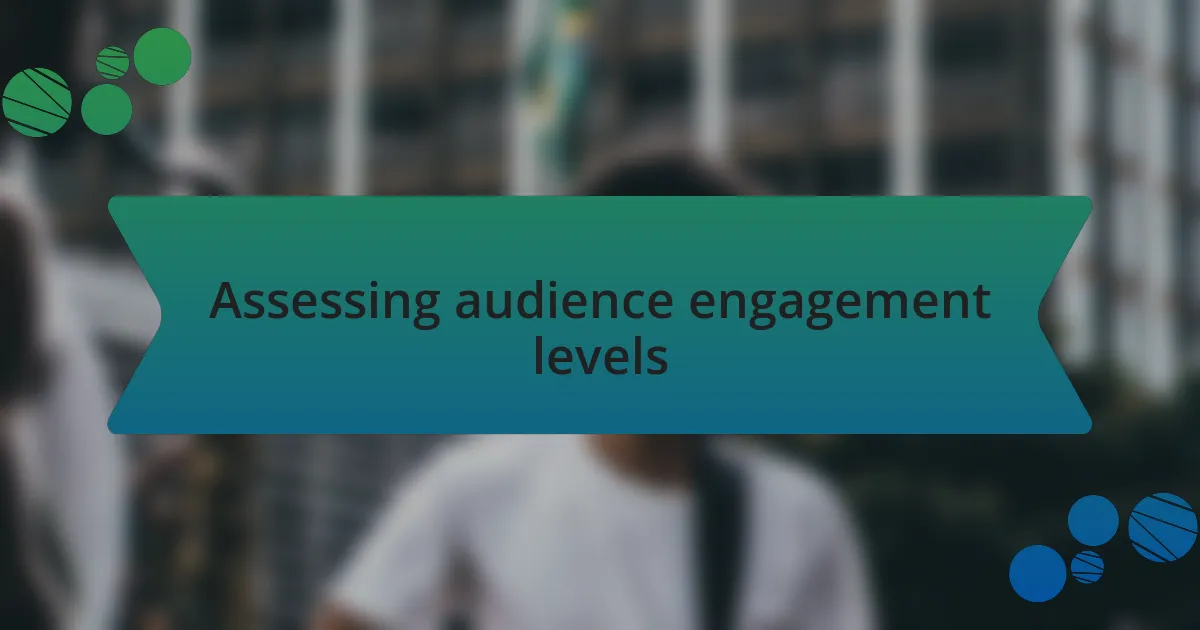
Assessing audience engagement levels
To truly understand audience engagement levels, I delve into the metrics of website traffic and user interaction. During a recent festival collaboration, I noticed a remarkable surge in visits to our site, particularly on pages featuring our sponsored artists. It made me realize how a well-placed sponsorship could act like a beacon, drawing fans in and creating a vibrant hub of activity. Have you ever clicked on a link just because it was associated with an artist you love? That kind of curiosity is a powerful driver of engagement.
Tracking engagement through comments and shares on social media can be revealing, too. I once managed a campaign where the artists actively participated in Q&A sessions, and the resulting buzz was electric. Fans eagerly chimed in with their thoughts and feelings, which not only fostered a sense of community but also gave me insight into what truly resonates with them. It’s fascinating to consider how much value artists can gain from engaging directly with their supporters. In your experience, how much do you feel an artist’s presence in discussions influences your connection to their work?
Ultimately, I find that audience retention is a vital metric in assessing engagement. For example, after a sponsorship activation, I often track how many users return to our platform. I’ve seen cases where dedicated fans become loyal followers, which speaks volumes about the effectiveness of the sponsorship. If a sponsorship genuinely aligns with an artist’s brand, it can create a community that feels invested in their journey. How often have you revisited an artist’s page because of a sponsorship that genuinely excited you?
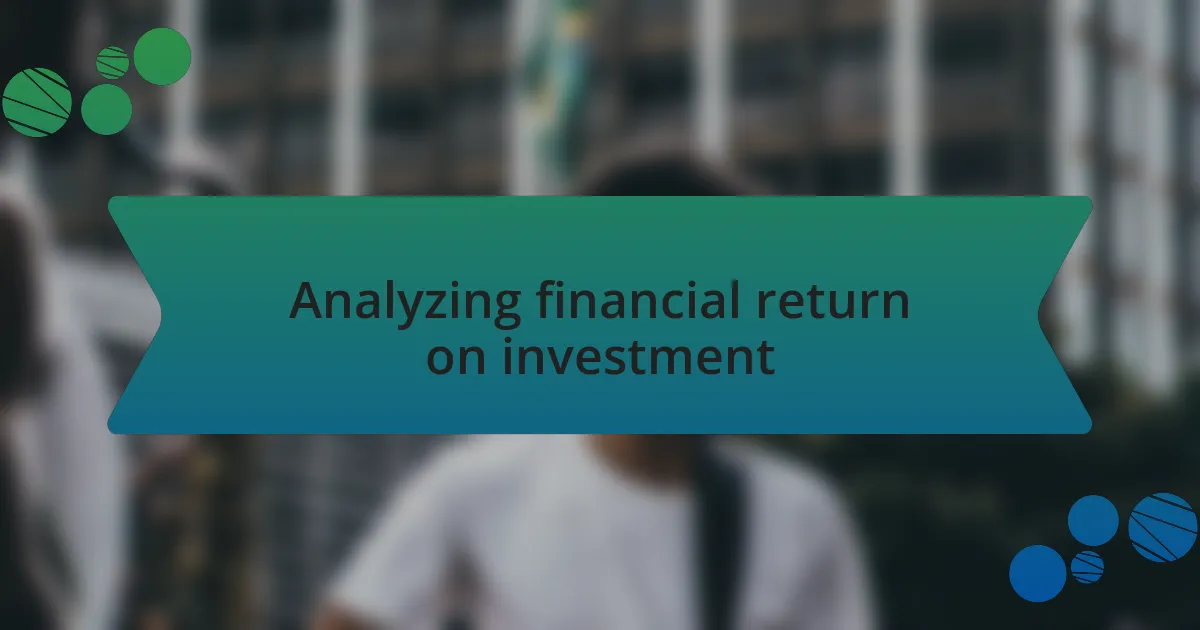
Analyzing financial return on investment
To accurately assess the financial return on investment (ROI) from sponsorships, I often look at sales data generated during specific campaigns. I recall a partnership with a rising DJ, where we carefully monitored merchandise sales over the sponsorship period. The spike we witnessed was not just satisfying; it illustrated how targeted sponsorship can convert exposure into tangible revenue.
Another critical aspect is analyzing the impact on streaming numbers. When I sponsored a series of playlists featuring the artist, I kept a close eye on their streaming growth. The result was a remarkable increase, proving that a well-placed sponsorship can elevate an artist’s visibility and directly influence financial outcomes. Have you noticed how certain playlists propel your favorite tracks up the charts?
Cost-per-acquisition (CPA) is another metric that I find invaluable. During one campaign, we calculated how much it cost to convert a new listener into a paying customer. Surprisingly, the figures showed a significant reduction in CPA after the sponsorship, affirming that our investment paid off in more ways than one. This concept of efficiency reignited my belief in the power of sponsorships to drive profitable growth. What are your thoughts on the importance of understanding these financial metrics in the world of music sponsorships?
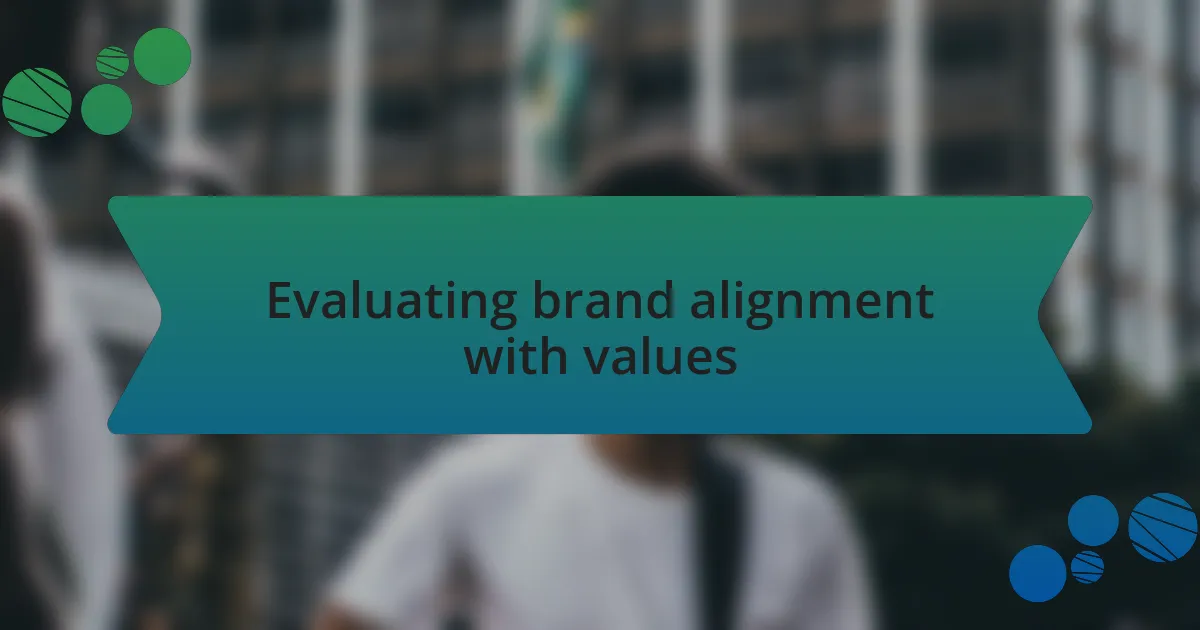
Evaluating brand alignment with values
When I evaluate brand alignment with values, I always start by looking at the core principles of both the sponsor and the artist. For instance, I recall a collaboration I pursued with an environmentally-focused music festival. Their commitment to sustainability resonated deeply with our label’s ethos, creating a sense of authenticity and synergy that was hard to ignore. I believe that when values align, it creates a genuine connection that audiences can sense.
Additionally, I analyze the messaging and campaigns of the brands we consider for sponsorships. During one project with a brand advocating for mental health awareness, it felt rewarding to see how our shared message amplified the dialogue around a vital issue. It reinforced my belief that alignment in values isn’t just beneficial for branding—it’s also about creating positive impact. Have you ever felt moved by a campaign that just “got” you?
Finally, I pay attention to how these alignments are perceived by our audience. For example, after a sponsorship with a brand that supports local artists, the feedback from our fans was overwhelmingly positive. It reminded me that sponsorships are not merely transactional; they’re about cultivating a community that embraces shared values. I’ve often wondered: how do we ensure these partnerships resonate genuinely with the audience’s belief systems?
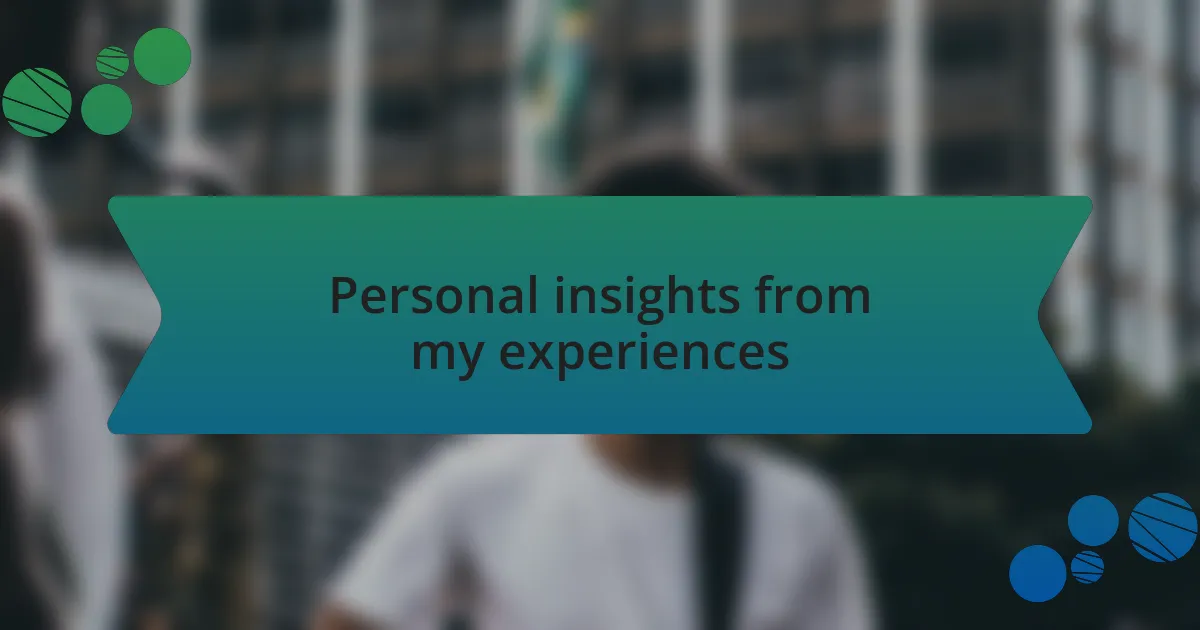
Personal insights from my experiences
When I think back on various sponsorships, one moment stands out—a partnership we forged with a local tech company that focused on innovation in music production. Witnessing their enthusiasm was inspiring; it reminded me that sponsorships can be partnerships driven by shared excitement, not just contracts. Have you ever encountered a collaboration that sparked an unexpected level of creativity?
In a different instance, we collaborated with a lifestyle brand that emphasized inclusivity in their campaigns. It was a powerful experience because I saw how their promotional content reflected our diverse community. This connection made me realize that sponsorships are more than just promoting a product; they help amplify voices within a broader narrative. Isn’t it amazing how a simple partnership can elevate shared stories?
One of the most enlightening sponsorships I experienced involved a brand known for its grassroots support of emerging artists. The way our community responded was overwhelmingly affirming. Seeing fans actively engage with and celebrate a brand that supports their favorite up-and-coming talent left me feeling validated in our choices—proof that meaningful engagement stems directly from thoughtful alignment. How often do we pause to appreciate the impact of our decisions on our creative landscape?